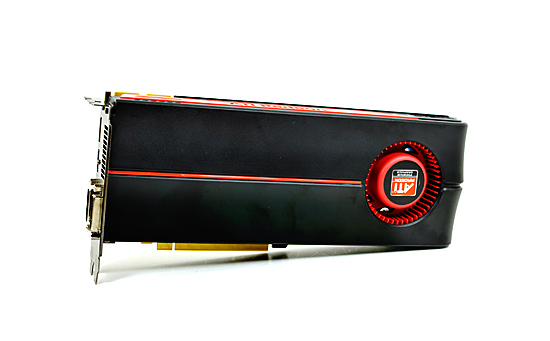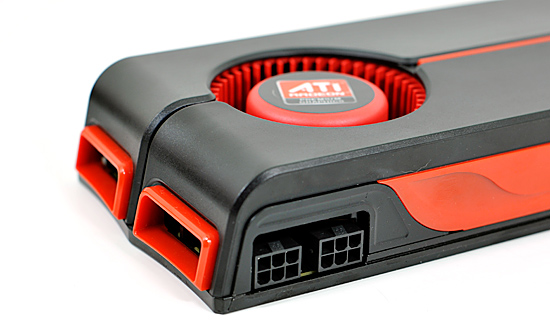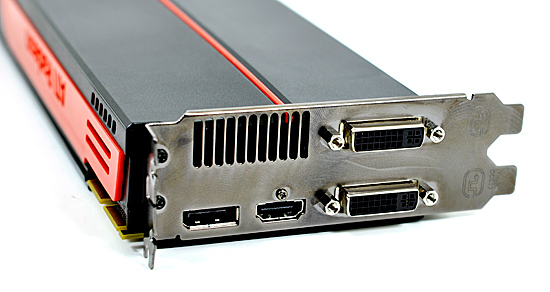AMD's Radeon HD 5870: Bringing About the Next Generation Of GPUs
by Ryan Smith on September 23, 2009 9:00 AM EST- Posted in
- GPUs
Meet the 5870
The card we’re looking at today is the Radeon HD 5870, based on the Cypress core.

Compared to the Radeon HD 4870, the 5870 has seen some changes to the board design. AMD has now moved to using a full sheath on their cards (including a backplate), very much like the ones that NVIDIA has been using since the 9800GTX. The card measures 10.5” long, an inch longer than the 4890 or the same as the 4870x2 and the NVIDIA GTX lineup.
The change in length means that AMD has moved the PCIe power connectors to the top of the card facing upwards, as there’s no longer enough room in the rear. Facing upwards is also a change from the 4870x2, which had them facing the front of the card. This, in our opinion, makes it easier to plug and unplug the PCIe power connectors, since it’s now possible to see what you’re doing.
Since the card has a TDP of 188W, AMD can still get away with using two 6-pin connectors. This is going to be good news for those of you with older power supplies that don’t feature 8-pin connectors, as previously the fastest cards without 8-pin connectors were the 4890 and GTX 285.

Briefly, the 5850 that we are not testing today will be slightly smaller than the 5870, coming in at 9.5”. It keeps the same cooler design, however the PCIe power connectors are back on the rear of the card.
With the 5800 series, DisplayPort is getting a much-needed kick in the pants. DisplayPort (full size) is standard on all 5800 series cards – prior to this it has been rather absent on reference cards. Along with a DisplayPort, the 5870 reference card contains a dedicated HDMI port, and a pair of DVI ports.
Making 4 ports fit on a card isn’t a trivial task, and AMD has taken an interesting direction in making it happen. Rather than putting every port on the same slot of the bracket as the card itself, one of the DVI ports is raised on to the other bracket. ATI could have just as easily only equipped these cards with 1 DVI port, and used an HDMI-to-DVI adapter for the second port. The advantage of going this direction is that the 5800 series can still drive two VGA monitors when using DVI-to-VGA adapters, and at the same time having an HDMI port built in means that no special adapters are necessary to get an HDMI port with audio capabilities. The only catch to this specific port layout is that the card still only has enough TMDS transmitters for two ports. So you can use 2x DVI or 1x DVI + HDMI, but not 2x DVI + HDMI. For 3 DVI-derived ports, you will need an active DisplayPort-to-DVI adapter.
With the configuration AMD is using, fitting that second DVI port also means that the exhaust vent of the 5800 series cards is not the full length of the card as is usually common, rather it’s a hair over half the length. The smaller size had us concerned about the 5870’s cooling capabilities, but as you’ll see with our temperature data, even with the smaller exhaust vent the load temperatures are no different than the 4870 or 4850, at 89C. And this is in spite of the fact that the 5870 is rated 28W more than the 4870.

With all of these changes also comes some changes to the loudness of the 5870 as compared to the 4870. The 27W idle power load means that AMD can reduce the speed of the fan some, and they say that the fan they’re using now is less noticeable (but not necessarily quieter) than what was on the 4870. In our objective testing the 5870 was no quieter than any of the 4800 series cards when it comes to idling at 46.6dB, and indeed it’s louder than any of those cards at 64dB at load. But in our subjective testing it has less of a whine. If you go by the objective data, this is a push at idle and louder at load.
Speaking of whining, we’re glad to report that the samples we received do not have the characteristic VRM whine/singing that has plagued many last-generation video cards. Most of our GTX cards and roughly half of our 4800 series cards generated this noise under certain circumstances, but the 5870 does not.
Finally, let’s talk about memory. Despite of doubling just about everything compared to RV770, Cypress and the 5800 series cards did not double their memory bandwidth. Moving from the 4870 and it’s 900MHz base memory clock, the 5870 only jumps up by 33% to 1.2Ghz, in effect increasing the ratio of GPU compute elements to memory bandwidth.
When looking back at the RV770, AMD believes that they were not bandwidth starved on the cards that used GDDR5. And since they had more bandwidth than they needed, it was not necessary to go for significantly more bandwidth for Cypress. This isn’t something we can easily test, but in our benchmarks the 5870 never doubles the performance of the 4870, in spite of being nearly twice the card. Graphics processing is embarrassingly parallel, but that doesn’t mean it perfectly scales. The different may be a product of that or a product of the lack of scaling in memory bandwidth, we can’t tell. What’s for certain however is that we don’t have any hard-capped memory bandwidth limited situations, the 5870 always outscores the 4870 by a great deal more than 33%.










327 Comments
View All Comments
Xajel - Wednesday, September 23, 2009 - link
Ryan,I've send a detailed solution for this problem to you ( Aero disabled when running and video with UVD accerelation ), but the basic for all readers here is just install HydraVision & Avivo Video Convertor packages, and this should fix the problem...
Ryan Smith - Wednesday, September 23, 2009 - link
Just so we're clear, Basic mode is only being triggered when HDCP is being used to protect the content. It is not being triggered by just using the UVD with regular/unprotected content.biigfoot - Wednesday, September 23, 2009 - link
Well, I've been looking forward to reading your review of this new card for a little while now, especially since the realistic sounding specs leaked out a week or so ago. My first honest impression is that it looks like it'll be a little bit longer till the drivers mature and the game developers figure out some creative ways to bring the processor up to its full potential, but in the mean time, it looks like I'd have to agree with everyone's conclusion that even 150+GB/s isn't enough memory bandwidth for the beast, I'm sure it was a calculated compromise while the design was still on the drawing board. Unfortunately, increasing the bus isn't as easy as stapling on a couple more memory controllers, they probably would've had to resort back to a wider ring bus and they've already been down that road. (R600 anyone) Already knowing how much more die area and power would've been required to execute such a design probably made the decision rather easy to stick with the tested 4 channel GDDR5 setup that worked so well for the RV770 and RV790. As for how much a 6 or 8 channel (384/512 bit) memory controller setup would've improved performance, we'll probably never know; as awesome as it would be, I don't foresee BoFox's idea of ATI pulling a fast one on nVidia and the rest of us by releasing a 512-bit derivative in short order, but crazier things have happened.biigfoot - Wednesday, September 23, 2009 - link
Oh, I also noticed, they must of known that the new memory controller topology wasn't going to cut it all the time judging from all the cache augmentations performed. But like i said, given time, I'm sure they'll optimize the drivers to take advantage of all the new functionality, I'm betting that 90% of the low level functions are still handled identically as they were in the last generations architecture and it will take a while till all the hardware optimizations like the cache upgrades are fully realized.piroroadkill - Wednesday, September 23, 2009 - link
The single most disappointing thing about this card is the noise and heat.Sapphire have been coming out with some great coolers recently, in their VAPOR-X line. Why doesn't ATI stop using the same dustbuster cooler in a new shiny cover, and create a much, much quieter cooler, so the rest of us don't have to wait for a million OEM variations until there's one with a good cooler (or fuck about and swap the cooler ourselves, but unless you have one that covers the GPU AND the RAM chips, forget it. Those pathetic little sticky pad RAM sinks suck total donkey balls.)
Kaleid - Wednesday, September 23, 2009 - link
Already showing up...http://www.techpowerup.com/104447/Sapphire_HD_5870...">http://www.techpowerup.com/104447/Sapphire_HD_5870...
It will be possible to cool the card quietly...
Dante80 - Wednesday, September 23, 2009 - link
the answer you are looking for is simple. Another, more elaborate cooler would raise prices more, and vendors don't like that. Remember what happened to the more expensive stock cooler for the 4770? ...;)Cookie Monster - Wednesday, September 23, 2009 - link
When running dual/multi monitors with past generation cards, the cards would always run at full 3d clocks or else face instabilities, screen corruptions etc. So even if the cards are at idle, it would never ramp down to the 2d clocks to save power, rending impressive low idle power consumption numbers useless (especially on the GTX200 series cards).Now with RV870 has this problem been fixed?
Ryan Smith - Wednesday, September 23, 2009 - link
That's a good question, and something we didn't test. Unfortunately we're at IDF right now, so it's not something we can test at this moment, either.Cookie Monster - Wednesday, September 23, 2009 - link
It would be awesome if you guys do get some free time to test it out. Would be really appreciated! :)